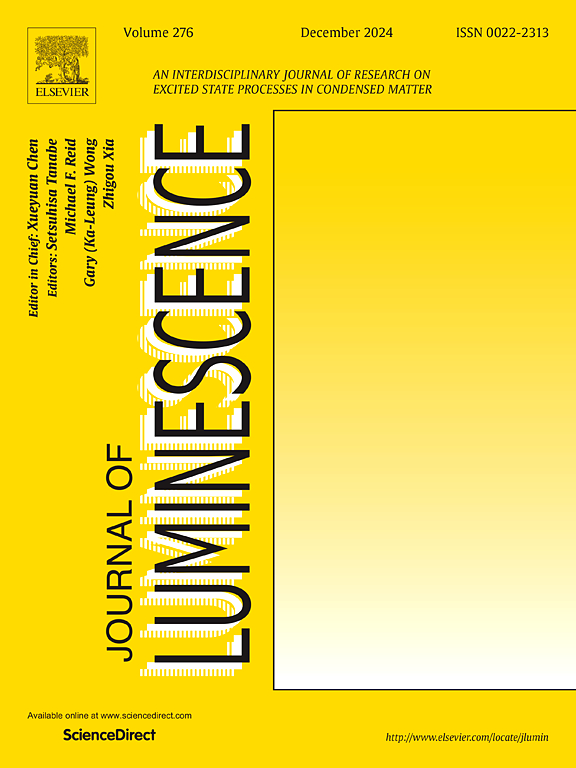一种新型的Ce3+和Na+掺杂KCaPO4陶瓷用于光激发发光剂量测定
IF 3.6
3区 物理与天体物理
Q2 OPTICS
引用次数: 0
摘要
本研究的目的是评价新开发的KCaPO4:Ce0.1%,Na0.1%的发光和剂量学性质。光激发发光(OSL)荧光粉的传统高温固相反应。我们研究了KCaPO4:Ce0.1%,Na0.1%的热致发光(TL), OSL和辐射致发光(RL)。这种新荧光粉在130°C(升温速率为3°C/s)有一个与Ce3+发射相关的主TL峰,这与获得的OSL信号相关。KCaPO4:Ce0.1%,Na0.1%陶瓷的RL发射光谱在385 nm处发射,归因于4f0 5d1→4f1(2F5/2)跃迁。该荧光粉的TL发射光谱在750 nm左右有很强的发射。对蓝光(470 nm)激发的KCaPO4:Ce0.1%,Na0.1%的相关剂量学性质进行了评价,包括剂量响应、最小可检测剂量、再现性和衰落。在1 ~ 50 Gy范围内,KCaPO4:Ce0.1%,Na0.1%的OSL响应与吸收剂量呈线性关系。在最初的24小时内观察到~ 5.8%的衰落,可能是由于浅陷阱,并在一周内接近~ 9.0%的衰落。掺杂镧系元素Ce3+和碱金属Na+后的磷酸基磷光体KCaPO4可能适用于个人剂量学、医学剂量学和核场所周围环境监测。Ce3+的快速发光特性也使该材料成为2D OSL剂量映射的有力候选材料。本文章由计算机程序翻译,如有差异,请以英文原文为准。
A novel Ce3+ and Na+ doped KCaPO4 ceramics for optically stimulated luminescence dosimetry
The aim of this work is to evaluate the luminescent and dosimetric properties of newly developed KCaPO4:Ce0.1%,Na0.1%. Optically Stimulated Luminescence (OSL) phosphor by conventional high temperature solid-state reaction. We investigated Thermoluminescence (TL), OSL, and radioluminescence (RL) of KCaPO4:Ce0.1%,Na0.1%. This new phosphor has a main TL peak at 130 °C (with a heating rate of 3 °C/s) associated with Ce3+ emission that is correlated with the obtained OSL signal. The RL emission spectrum of the KCaPO4:Ce0.1%,Na0.1% ceramic gives an emission at 385 nm attributed to the 4f0 5d1 →4f1(2F5/2) transition. The TL emission spectra of this phosphor gave a strong emission around 750 nm. The relevant dosimetric properties of the blue light (470 nm) stimulated KCaPO4:Ce0.1%,Na0.1% comprising the dose response, minimum detectable dose, reproducibility and fading were evaluated for applications in OSL dosimetry. The OSL response of KCaPO4:Ce0.1%,Na0.1% is linear as a function of the absorbed dose between 1 and 50 Gy. Fading of ∼5.8% was observed in the first 24 h, probably due to shallow traps, and approached fading of ∼9.0% in a week. This phosphate-based phosphor KCaPO4 after doping with lanthanide Ce3+ and alkali metal Na+ are potentially suitable for personal dosimetry, medical dosimetry and environmental monitoring around nuclear sites. The fast luminescence character of Ce3+ make this material also a strong candidate for 2D OSL dose mapping.
求助全文
通过发布文献求助,成功后即可免费获取论文全文。
去求助
来源期刊

Journal of Luminescence
物理-光学
CiteScore
6.70
自引率
13.90%
发文量
850
审稿时长
3.8 months
期刊介绍:
The purpose of the Journal of Luminescence is to provide a means of communication between scientists in different disciplines who share a common interest in the electronic excited states of molecular, ionic and covalent systems, whether crystalline, amorphous, or liquid.
We invite original papers and reviews on such subjects as: exciton and polariton dynamics, dynamics of localized excited states, energy and charge transport in ordered and disordered systems, radiative and non-radiative recombination, relaxation processes, vibronic interactions in electronic excited states, photochemistry in condensed systems, excited state resonance, double resonance, spin dynamics, selective excitation spectroscopy, hole burning, coherent processes in excited states, (e.g. coherent optical transients, photon echoes, transient gratings), multiphoton processes, optical bistability, photochromism, and new techniques for the study of excited states. This list is not intended to be exhaustive. Papers in the traditional areas of optical spectroscopy (absorption, MCD, luminescence, Raman scattering) are welcome. Papers on applications (phosphors, scintillators, electro- and cathodo-luminescence, radiography, bioimaging, solar energy, energy conversion, etc.) are also welcome if they present results of scientific, rather than only technological interest. However, papers containing purely theoretical results, not related to phenomena in the excited states, as well as papers using luminescence spectroscopy to perform routine analytical chemistry or biochemistry procedures, are outside the scope of the journal. Some exceptions will be possible at the discretion of the editors.
 求助内容:
求助内容: 应助结果提醒方式:
应助结果提醒方式:


